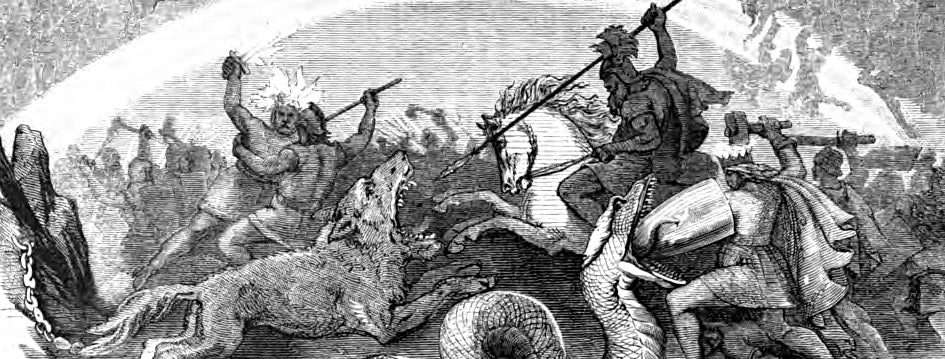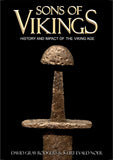Thanks for visiting our blog! As a thank-you, enjoy 15% off your first order in our online Viking Shop with the discount code BLOG15.
The Vikings believed all things – even the gods themselves – were bound to fate. The concept was so important that there were six different words for fate in the Old Scandinavian tongues. As Daniel McCoy writes, “Fate occupied roughly the same position in the Norse worldview that the laws of science do in the modern world; it provided an unseen guiding principle that determined how events in the world would unfold, and could explain them after they occurred”. 1 It was in large part this deep conviction that “fate is inexorable” that gave the Vikings their radical stoicism. Because the outcome was determined, it was not for a man or a woman to try to escape their fate – no matter how grim it might be. The essential thing was in how one met the trials and tragedies that befell them. We see this in the Viking idea of Valhalla – the heavenly hall where the souls of those who have died valiantly feast and fight beside the gods. But this submission to fate is even stronger and starker when we consider the purpose of Valhalla. The gods were not simply drawing the souls of the worthy and the brave to them as a reward – they were calling for heroes because they needed them. The reason they needed them was because Ragnarok, the inevitable cataclysmic destruction of everything and the end of the world, would one day come. 2
Like the Apocalypse of Christianity, Ragnarok is the culmination of a series of prophesied events. No one knew when it was supposed to happen (in fact, just as some Christians throughout history have believed they were living in the end times, as the Viking Age waned, some Norse believed they were living through the tribulations of Ragnarok). They could only look for the signs.
This great doom was set into motion with the murder of the beloved god, Baldur, by the hand of Loki. Loki was bound for this crime, in a deep cave where he was tormented by the burning poison of a magical serpent. 1 But Loki swore revenge and will one day throw in his lot with the giants and Hel, goddess of the underworld and keeper of the ignoble dead. Furthering his treachery, Loki will lead the giants in a massive assault on Asgard, the home of the gods.
People will know that Ragnarok is beginning when a great winter takes hold of the earth. The sun and the moon shall be devoured by wolves, and mankind will abandon faith, loyalty, and honor. 3 Great wars will break out, and the world will be battered by floods, winds, and famines. Yggdrasil itself will shake. 4 But all of that is just the preamble to the destruction that awaits.
Hel’s ship, Nalgfar – a longship made from the fingernails of all the forgotten dead – will rise from the bottom of the cold ocean. It will be oared by giants – ancient enemies of the gods who are each supernatural beings of chaos. The ship will be helmed by Loki, who will lead it to Bifrost, the rainbow bridge that is the entrance into Asgard. They will not come alone, for all the horrible monsters that the gods had fought so bravely to bind will break free and will join the attack. This army of abomination will crush Bifrost under their weight and will lay waste to Asgard. 4
But the gods are not so easily undone. Odin, Thor, Heimdall, Frey and Freya, and all the others will lead the heroes of Valhalla onto the “field of surging battle”, a place called Vigrid. 1 There the last battle will rage. Odin will don his eagle helmet and ride his eight-legged charger (Sleipnir) straight at the great wolf, Fenrir; but before the All-Father can level his spear at the beast’s heart he will be devoured by the giant wolf. 2

Odin’s son Vidar will slay Fenrir, but die in turn. Thor will battle the world-coiling serpent, Jormungandr; and though he finally slays his ancient nemesis with his hammer, he will collapse dead from the snake’s venom. 5 Heimdall and Loki will die on each other’s blades. One by one, the gods and heroes will fall; and as they do, there will be nothing to save the world from the giant’s fire. The fire will consume every one of the nine worlds. The giants and creatures of darkness, too, will die by the fire and destruction they have created. All shall perish and fall into the sea, and everything will be as it was before creation ever happened. 4,5,6

Many of the older accounts leave it at that. Other accounts (particularly the ones written down many years after the worship of Odin had faded) go on to describe a rebirth. 1 There will be a new creation of the world(s) these sagas say; and a few descendents of both gods and humankind will survive Ragnarok and the coming darkness. These descendents will repopulate the earth, and life and light will return. 5 Many experts find in this epilogue evidence that the Norse view of time was cyclical, a circle of creation and destruction. Others see in the story attempts by later writers to introduce some of their own Christian ideas into the tale, a way to exonerate the abandoned beliefs of their people as being precursors to the faith they went on to hold. 3 At least one of these sagas, The Song of the Seeress, is less than subtle in that regard, when it talks about one great god who would then rule over all in this new creation (though some experts argue this stanza may have been tacked on later). 5 As we consider these different versions of the story and their different interpretations, it is important to remember that Viking religion was not a structured, codified faith with scriptures and dogmas the way most religions we are acquainted with today are. Rather, it was a flexible, fluid, adaptive culture that lived through stories and songs from many voices. 1 Hence there is no correct or incorrect view of Ragnarok.
Ragnarok is a hard story. It is a grim tale of doom, where those of us who have listened to the many wonderful tales of gods and heroes must now watch them die. It would have been many times more distressing than that for the Vikings, who wore the symbols of these gods, and put their faith in them. Whether this doom led to rebirth or not did not change the horror of the events the Vikings fully expected to come true. Again, this is where we see a clear view of the Viking heart. Just as Odin, Thor, and the gods of Asgard were not afraid to stand shoulder to shoulder with worthy souls and fight unimaginable, invincible foes, so also the Viking knew that he or she was to face adversity, fear, tragedy, and loss the very same way. With a sword in hand and a shout on their lips, the Viking would never ask for any lighter fate or any lesser doom – only to be given the chance to live and die well, as the gods do.
Sons of Vikings is an online store offering hundreds of Viking inspired items, including Viking jewelry, Viking clothing, Drinking horns, home decor items and more.
To learn more about Viking history, we recommend our 400+ page, self titled book that is available here.
Contributing Author
David Gray Rodgers is a career fire officer who holds a bachelor’s in history and a master’s in business administration. He has published several books, including Sons of Vikings (history of Vikings book) and Usurper: A Novel of the Fall of Rome.
References
1. McCoy, D. The Viking Spirit: An Introduction to Norse Mythology and Religion. Columbia. 2016
2. Brown, N.M. Songs of the Vikings: Snorri and the Making of the Norse Myths. Palgrave MacMillan, New York. 2012
3. McCoy, D. Ragnarok. Norse Mythology for Smart People. Retrieved from https://norse-mythology.org/tales/ragnarok/. Published 2017. Accessed November 3, 2017.
4. Brodeur, A. G. The Prose Edda of Snorri Sturlson. Retrieved from http://www.redicecreations.com/files/The-Prose-Edda.pdf. Published 1916, Accessed November 3, 2017.
5. Bellows, H.A. Voluspo from The Poetic Edda. Retrieved from http://www.sacred-texts.com/neu/poe/poe03.htm. Published 1936. Accessed November 3, 2017.
6. Bellows, H. A. Vafthruthnisimol from The Poetic Edda Retrieved from http://www.sacred-texts.com/neu/poe/poe05.htm. Published 1936. Accessed November 3, 2017
Images used: Battle of the Doomed Gods (by Friedrich Wilhelm Heine, 1882), Odin and Fenrir (depiction by Emil Doepler, 1905) and Thor and the Midgard Serpent (by Emil Doepler, 1905)
About Us:
SonsOfVikings.com offers hundreds of Viking Jewelry pieces to choose from:



